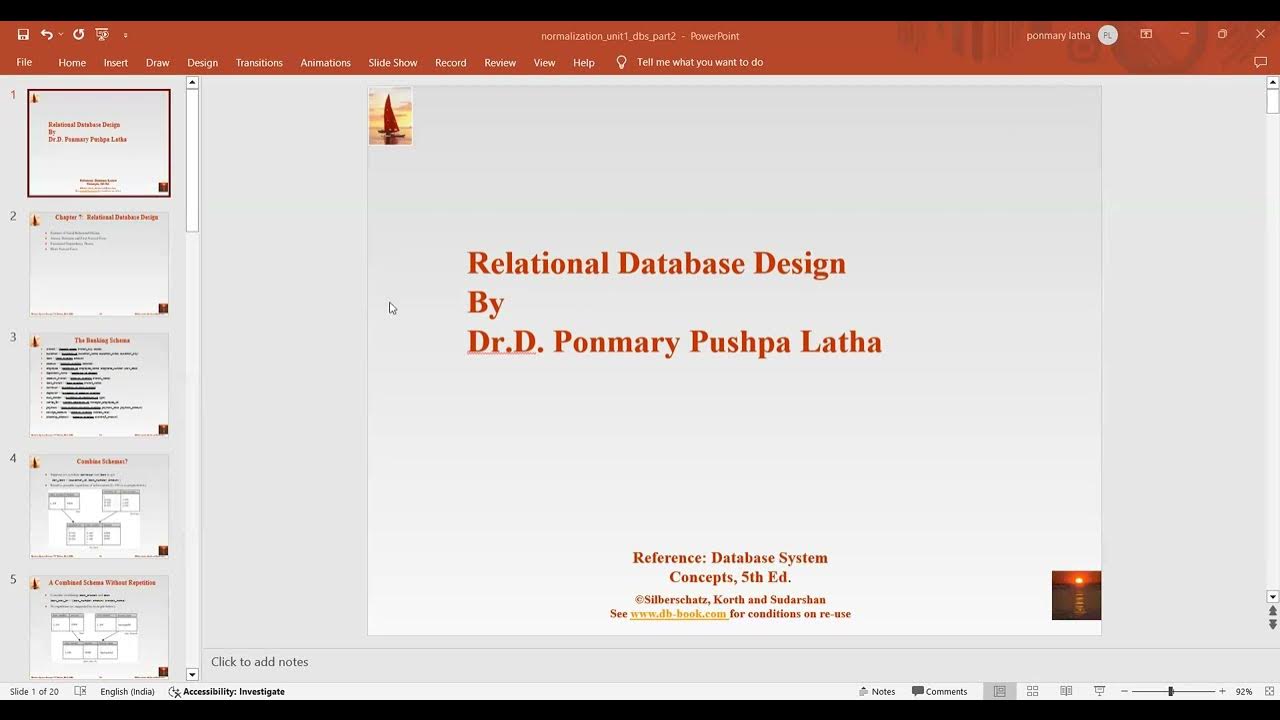Types of Normalization in DBMS in Hindi|1NF | 2NF | 3NF | BCNF| 4NF | 5NF in DBMS| With Example
Summary
TLDRThis video provides an in-depth explanation of normalization in database management systems (DBMS), specifically focusing on the different normal forms (1NF, 2NF, 3NF, BCNF, 4NF, and 5NF). The speaker emphasizes the importance of understanding key concepts such as atomic values, partial dependencies, transitive dependencies, and multi-value dependencies. Using examples, the video clarifies how to move from one normal form to the next, offering practical steps to structure data efficiently and ensuring that it adheres to relational database standards. It's an essential guide for students preparing for exams or working with database systems.
Takeaways
- 😀 Understanding normalization in DBMS is crucial for mastering the subject, and the process is explained in various stages across normal forms.
- 😀 First Normal Form (1NF) requires that all attribute values be atomic, meaning they cannot be further subdivided.
- 😀 Second Normal Form (2NF) builds on 1NF by ensuring no partial dependency exists, meaning all non-key attributes must depend fully on the primary key.
- 😀 Third Normal Form (3NF) removes transitive dependencies, ensuring that non-key attributes do not depend on other non-key attributes.
- 😀 Boyce-Codd Normal Form (BCNF) ensures that every determinant is a super key, helping eliminate anomalies caused by functional dependencies.
- 😀 Fourth Normal Form (4NF) deals with multi-valued dependencies, requiring that no attribute in a relation can have multiple independent values.
- 😀 Fifth Normal Form (5NF) focuses on eliminating join dependencies, ensuring that a relation cannot be decomposed further without losing information.
- 😀 To effectively prepare for exams, it's crucial to memorize keywords related to each normal form (1NF: Atomic values, 2NF: No partial dependency, 3NF: No transitive dependency, BCNF: Super key dependency, 4NF: No multi-valued dependency, 5NF: No loss of composition).
- 😀 Functional dependencies are key concepts in normalization, and every non-key attribute must depend fully on the key for higher normal forms.
- 😀 The process of normalization is best understood layer by layer, as each normal form builds on the principles of the previous one to create a more efficient database design.
Q & A
What is the main focus of this video?
-The main focus of the video is on the different types of normalization or normal forms in Database Management Systems (DBMS), specifically explaining the concepts of first normal form (1NF), second normal form (2NF), third normal form (3NF), Boyce-Codd Normal Form (BCNF), fourth normal form (4NF), and fifth normal form (5NF).
Why is it important to watch the previous video before this one?
-It is important to watch the previous video because it covers the basic concepts of normalization and functional dependencies. Understanding these concepts is essential for grasping the detailed explanation of the normal forms in this video.
What is an atomic value in the context of 1NF?
-In the context of 1NF, an atomic value refers to a value that cannot be further divided. Each attribute in a relation must have atomic values, meaning no attribute should contain multiple values or sets of values in a single entry.
What is the condition for a relation to be in 2NF?
-For a relation to be in 2NF, it must first satisfy the conditions of 1NF. Additionally, it should not have any partial dependencies, meaning that non-key attributes should be fully dependent on the primary key, not just part of it.
What does 'no transitive dependency' mean in 3NF?
-In 3NF, 'no transitive dependency' means that non-key attributes should not be dependent on other non-key attributes. A transitive dependency occurs when an attribute depends on another attribute that is not the primary key, which violates the 3NF condition.
What is Boyce-Codd Normal Form (BCNF), and how is it different from 3NF?
-BCNF is a stricter version of 3NF. While 3NF ensures that non-key attributes are not transitively dependent on the primary key, BCNF requires that every determinant in a relation is a candidate key. This means there should be no exceptions where a non-candidate key determines other attributes.
What is the role of multivalued dependencies in 4NF?
-In 4NF, the primary condition is the removal of multivalued dependencies. A multivalued dependency occurs when an attribute determines multiple independent attributes, and this can lead to redundant data. To satisfy 4NF, such dependencies need to be eliminated.
What does 'lossless decomposition' mean in the context of 5NF?
-Lossless decomposition in 5NF means that when a relation is decomposed into smaller relations, no information should be lost. The decomposition should ensure that all the original data can be reconstructed by joining the smaller relations without any loss of information.
How can a relation be in both 3NF and BCNF?
-A relation can be in both 3NF and BCNF if it satisfies all the conditions of 3NF, and additionally, every determinant is a candidate key, fulfilling the stricter requirement of BCNF. In other words, BCNF ensures no functional dependency exists where the determinant is not a candidate key.
What is the significance of the student ID in the examples of 1NF, 2NF, and 3NF?
-The student ID is used as the primary key in the examples to demonstrate how attributes like student name, project name, and course details depend on it. The video illustrates how to break down the relations in 1NF (atomic values), 2NF (removing partial dependencies), and 3NF (eliminating transitive dependencies) using the student ID.
Outlines

このセクションは有料ユーザー限定です。 アクセスするには、アップグレードをお願いします。
今すぐアップグレードMindmap

このセクションは有料ユーザー限定です。 アクセスするには、アップグレードをお願いします。
今すぐアップグレードKeywords

このセクションは有料ユーザー限定です。 アクセスするには、アップグレードをお願いします。
今すぐアップグレードHighlights

このセクションは有料ユーザー限定です。 アクセスするには、アップグレードをお願いします。
今すぐアップグレードTranscripts

このセクションは有料ユーザー限定です。 アクセスするには、アップグレードをお願いします。
今すぐアップグレード5.0 / 5 (0 votes)






